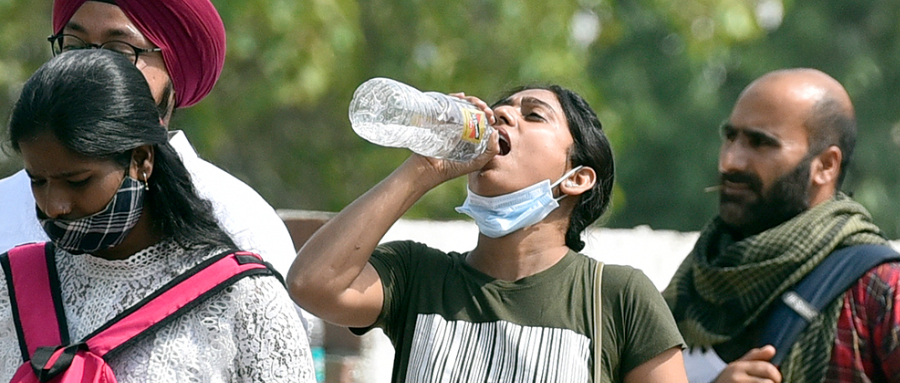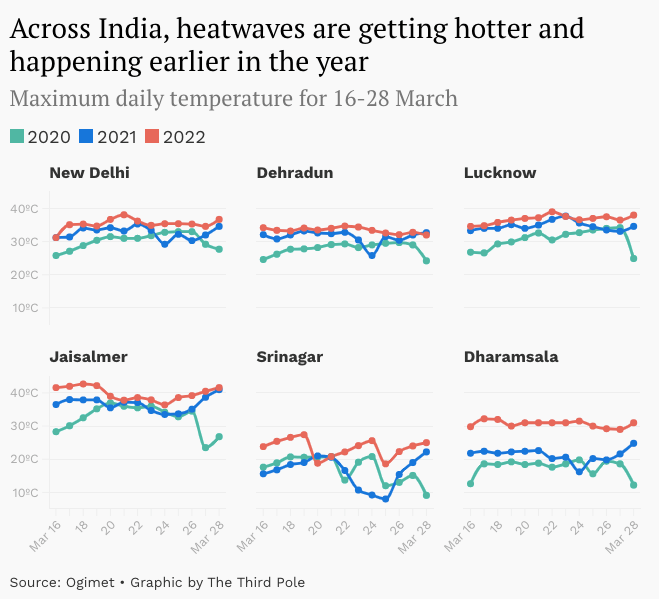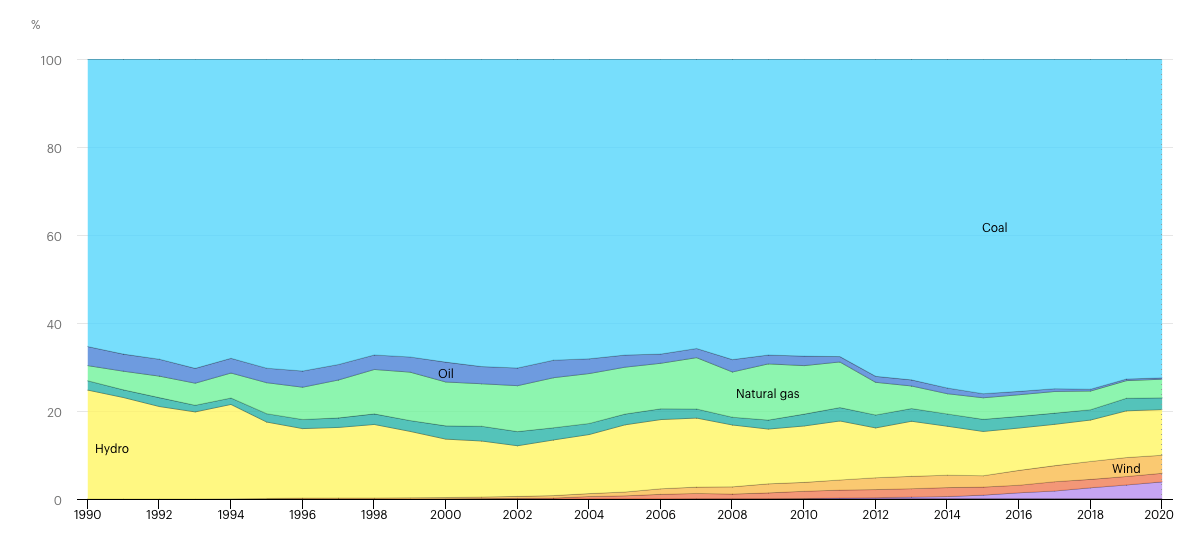

Since late March 2022, India has been suffering persistent hot weather, with temperatures soaring above 40 degrees Celsius in several regions of the north, west, and east, and at least 25 people have died consecutively in India due to the heatwave.[1] According to the Indian Meteorological Department on May 15, the temperature in parts of the Indian capital, New Delhi, exceeded 49 degrees Celsius, 5 degrees Celsius higher than the average temperature for the same period in the past.[2]
Figure 1. Temperature trend of different cities in India in mid-late March

Unusually high temperatures lead to power shortages: several union territories suffer temporary power outages
India is experiencing its worst power crisis in more than six years as demand for electricity surges due to high temperature. Since late March, India's electricity demand has been setting new records, hitting a record high in April, with demand up 13.2% to 135.4 billion kWh.[3] To combat the heat, Indian companies and households have turned on their air conditioners or fans, but the increased demand has led to more frequent power outages. Local Circles conducted a survey of almost 22,000 homes in 322 rural and urban regions in India and discovered that two-thirds of respondents experienced power outages during the heat, with one-third experiencing outages lasting more than two hours.[4]Due to the increase in electricity demand, power generation companies are experiencing acute coal shortages, resulting in power outages in various Indian states. The lack of power supply caused by this year's heatwave also underscores the urgency of energy diversification in India, especially considering India's vast and dense population, and the fact that future population growth would further increase India's demand for electricity.
Coal production surges: India's energy transition is slow
Electricity shortages have prompted India to reconsider its long-standing reliance on coal. India is the world’s second largest producer and consumer of coal, with over 70 percent of is electricity coming from coal, followed by hydropower and natural gas (Figure 2). According to the Central Electricity Authority of India, as the end of April 2022, most of India's 165 coal-fired power plants had coal stocks below 25%, and more than a third had coal stocks below 10%, and 26 had coal stocks of less than 5%.[5]
Figure 2. Share of each source of electricity generation in India, 1990-2020

From: IEA
Since the beginning of April this year, the average coal inventory of India's coal-fired power plants is nine days, which is the lowest level for the same period since 2014. Indian federal guidelines recommend that coal-fired power facilities need to have an average of at least 24 days of coal stock. [6] Coal India, which produces more than 80 percent of India's coal, is on track to achieve a new peak in 2022, with coal production presently exceeding 600 million tons and projected to continue increasing. The corporation also intends to expand its coal supply to coal-fired power plants by 4.6% this fiscal year to 565 million tons.[7] In addition, imported coal may compensate for a portion of India's coal shortage. India's power sector has asked power companies to ensure that 19 million tons of coal is delivered from overseas by the end of June.[8] However, because the Russian-Ukrainian conflict has led to soaring global coal prices, a large quantity of imported coal will cause India's power companies' operating costs to continue to increase.
Increasing the proportion of renewable energy in the country's energy mix is one strategy to address climate change and lessen reliance on coal. As heatwaves caused by climate change become more frequent and energy shortages become more common, expanding India's reliance on coal is not a viable long-term answer; instead, investments should be made to develop renewable and flexible sources of power generation. In November 2021, at the 26th United Nations Climate Change Conference (COP26) in Glasgow, Scotland, Indian President Modi pledged that by 2030, 50 percent of India's energy consumption would come from renewable sources and plans to install 500 gigawatts (GW) of renewable power generation capacity to help reduce reliance on coal. India's renewable energy generation capacity is approximately 152GW [9][10] (two-thirds of which is installed photovoltaic and wind power capacity), and it will be difficult for India to reach its 500GW target in the next eight years. Coupled with the current increase in India's demand for coal, India's energy transition is gradually decelerating.
While India is working to increase the use of and investment in renewable energy, coal use has not yet peaked and the rise of renewables is not enough to end the growth in coal use. In contrast to the accelerated deployment of renewables, India should also pursue coal clean-up at the same time. India's coal has a high ash content and low calorific value. In India, more than 90 percent of coal is mined from open-pit mines, which typically have ash contents between 35 and 50 percent, making it a serious source of air pollution and public health problems.[11] According to a study by Greenpeace, emissions from coal-fired power generation in India may cause more than 100,000 premature deaths each year.[12]
Conclusion
The International Energy Agency (IEA) predicts that India's energy consumption will increase faster than that of any other nation between now and 2040.[13] If this is to be achieved while reducing coal consumption, India will need to develop renewable energy faster to reach its climate target of achieving net-zero emissions by 2070. As a developing nation, India's development and deployment of renewable energy would also require substantial overseas investment. Last year India pledged at COP26 to phase down its coal use, but this year's extreme heat pushed India's electricity demand to an all-time high, resulting in the worst power crisis in more than six years and forcing India to backtrack its policy of reducing coal imports, making it even more difficult and daunting to meet its net-zero emissions goal.
Note:
[1] Extreme heat kills at least 25 in India's Maharashtra state, Reuters. Link: https://www.reuters.com/world/india/extreme-heat-kills-least-25-indias-maharashtra-state-2022-05-03/
[2] Delhi turns into hot cauldron; mercury leaps to 49 deg C in parts of city, The Economic Times. Link: https://economictimes.indiatimes.com/news/india/delhi-turns-into-hot-cauldron-mercury-leaps-to-49-deg-c-in-parts-of-city/articleshow/91579343.cms
[3] Unrelenting heat in India pushes April power demand to record high, Reuters. Link: https://www.reuters.com/world/india/unrelenting-heat-india-pushes-april-power-demand-record-high-2022-05-02/
[4] WHY INDIA’S HEATWAVE HAS TURNED OUT THE LIGHTS, Link: https://www.preventionweb.net/news/why-indias-heatwave-has-turned-out-lights
[5] India suffers from "coal shortage" and will continue to face power shortage,
link: https://news.bjx.com.cn/html/20220512/1224412.shtml
[6] India to face more power cuts due to coal shortage, soaring demand, Reuters, Link: https://www.reuters.com/world/india/india-face-more-power-cuts-due-coal-shortage-soaring-demand-2022-04-12/
[7] Same as 6
[8] India sets end-June coal import targets as power woes mount, Reuters, Link: https://jp.reuters.com/article/india-coal-imports-idAFL3N2WU1JQ
[9] COP26: India PM Narendra Modi pledges net-zero by 2070, BBC News, Link: https://www.bbc.com/news/world-asia-india-59125143
[10] As told to Parliament (March 22, 2022): India has installed renewable energy projects of 152 GW capacity, Link: https://www.downtoearth.org.in/news/renewable-energy/as-told-to-parliament-march-22-2022-india-has-installed-renewable-energy-projects-of-152-gw-capacity-82037
[11] Economic and Environmental Impact of Coal Washing in India(2020), The Energy and Resources Institute, p3.
[12] Coal-Fired Power in India May Cause More Than 100,000 Premature Deaths Annually, Link: https://www.scientificamerican.com/article/coal-fired-power-in-india-may-cause-more-than-100000-premature-deaths-annually/
[13] India Energy Outlook 2021, IEA, Link: https://www.iea.org/reports/india-energy-outlook-2021
Author: Yuan Yating
Translation: Duan Yuxuan
Proofread: Yuan Yating
This article is an original article of the Rock Environment and Energy Institute. Please contact us to obtain the appropriate authorization to reprint. For cooperation and authorization, please send an email to: liying@reei.org.cn
* This is the translation of an article in Chinese. Should there be any inconsistency between Chinese and English version, the Chinese version shall prevail.




